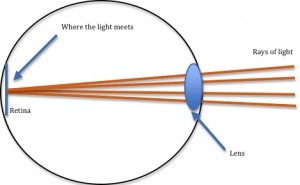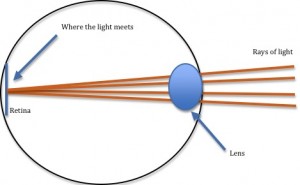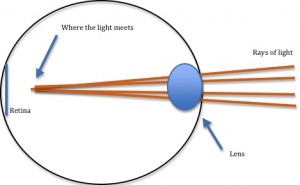We all know that 20/20 vision means “perfect vision”, right? But what does 20/20 actually mean? And is it really the best way to measure someone’s vision?
Someone who has “normal” vision, can read the 20/20 line on the eye chart. If someone has 20/50 vision, that means that they can read at 20 feet away, what someone with 20/20 vision can see from 50 feet away. The less acuity that someone has in their eyes, that farther away someone with 20/20 vision can see the same object or read the same line.
Why is the number 20 the baseline? Because when you’re looking at something 20 feet away, the lens of your eye is in a neutral, relaxed state, like the image below:
And the lens of the eye will remain in the state no mater how far away you’re looking at something. If you’re looking at a mountain range that’s a few miles away, the lens of your eye remains in the same position, than if you were looking at something 30 feet away.
It’s when you look at something less than 20 away that the lens of the eye moves. If you’re reading a book, or working on the computer, or looking at your cell phone, this is what the lens of the eye does:
When your eye is in this state for a long time (and most of us do keep our eyes locked like this because our everyday activities demand it) the muscles will eventually no longer be able to hold their elasticity. When that happens, the light that enters the eye does this:
If someone needs glasses, that means that the light entering their eyes meets either before, or after it hits the retina. For normal, clear vision, the light must meet directly on the retina.
Glasses compensate for this discrepency and reangle the light that enters the eye so that it meets on the retina.
The problem with this is that the lens of the eye stays in its stressed shape. It’s never allowed to rest.
Someone who doesn’t wear glasses relaxes their vision each time they look at something more than 20 feet away, but someone who wears glasses never lets their eyes rest unless they take off their glasses (which usually is quite rare).
And here lies the problem. Vision is always fluctuating. Someone who has 20/20 vision might have 20/25 vision the next day, and then go back to 20/20, because vision has a direct connection to the stress that a person feels.
Vision Tests Are an Abnormal Way of Testing Eyesight
When someone goes in for an eye exam, they’re vision is measured under extremely abnormal conditions.
First of all, the lights are usually off. Normally people usually read something with the light on, not off.
Second of all the person may be feeling stressed. It could be because of the eye exam, or it could be because of something else going on in their life.
It’s irrelevant to the eye exam, and if their vision is slightly off, the doctor prescribes them glasses.
As soon as they put the glasses on, they have stopped the lens in their eye from working properly, essentually condemned themselves to wearing glasses for the rest of their lives.
How To Get the Most Accurate Readings from the Eye Exam
Here are 2 ways to make sure that if you do undergo an eye exam, that you’ll get the prescription that’s a) right for you and b) if you have only a small refraction, that you won’t be prescribed lens*:
The first is to maintain healthy eye habits. Make sure to give your eyes the nutrition they need. Make sure to do eye exercises and when you’re working on the computer or doing an other near-point activity, follow The Rule of 10.
The 2nd thing is if you must undergo an eye exam try to be as relaxed as possible before you go in. Do your eye exercises and be sure to be as calm and relaxed as possible. Yoga helps, so does meditation. The best thing would be to make sure you have a solid program for doing eye exercises and be sure to wear your pinhole glasses when you can.
—–
The bottom line is really to insure that you have good health overall. Take care of your body, and it will take care of you.
Remember, the body is designed to be healthy. Don’t be condemned to wearing glasses for the rest of your life. Take back your freedom!!!
—
*Little known fact, you only need 20/40 to be able to drive a car, not 20/20. If you have 20/40, 20/30, or even 20/25 they will still give you glasses to correct your “vision problem”. Even though you’re perfectly capable of seeing without them!
------------ Liked what you read? Join the hundreds of others who have downloaded and benefited from my Free e-book on Vision Improvement. Click this link and I'll send it over!.


One Reply to “What Does 20/20 Vision Mean? And How It’s The Worst Way to Measure Eyesight”